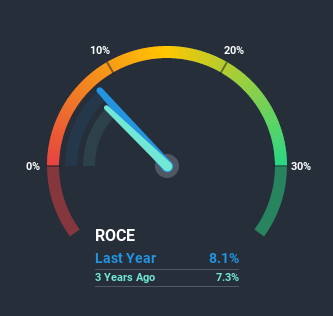- Singapore
- /
- Oil and Gas
- /
- SGX:Y35
Here's What To Make Of AnAn International's (SGX:Y35) Returns On Capital

If you're not sure where to start when looking for the next multi-bagger, there are a few key trends you should keep an eye out for. Typically, we'll want to notice a trend of growing return on capital employed (ROCE) and alongside that, an expanding base of capital employed. If you see this, it typically means it's a company with a great business model and plenty of profitable reinvestment opportunities. In light of that, when we looked at AnAn International (SGX:Y35) and its ROCE trend, we weren't exactly thrilled.
What is Return On Capital Employed (ROCE)?
For those that aren't sure what ROCE is, it measures the amount of pre-tax profits a company can generate from the capital employed in its business. The formula for this calculation on AnAn International is:
Return on Capital Employed = Earnings Before Interest and Tax (EBIT) ÷ (Total Assets - Current Liabilities)
0.081 = US$10m ÷ (US$379m - US$255m) (Based on the trailing twelve months to September 2020).
Therefore, AnAn International has an ROCE of 8.1%. On its own that's a low return, but compared to the average of 6.5% generated by the Oil and Gas industry, it's much better.
View our latest analysis for AnAn International

Historical performance is a great place to start when researching a stock so above you can see the gauge for AnAn International's ROCE against it's prior returns. If you'd like to look at how AnAn International has performed in the past in other metrics, you can view this free graph of past earnings, revenue and cash flow.
What The Trend Of ROCE Can Tell Us
We've noticed that although returns on capital are flat over the last five years, the amount of capital employed in the business has fallen 34% in that same period. When a company effectively decreases its assets base, it's not usually a sign to be optimistic on that company. In addition to that, since the ROCE doesn't scream "quality" at 8.1%, it's hard to get excited about these developments.
Another point to note, we noticed the company has increased current liabilities over the last five years. This is intriguing because if current liabilities hadn't increased to 67% of total assets, this reported ROCE would probably be less than8.1% because total capital employed would be higher.The 8.1% ROCE could be even lower if current liabilities weren't 67% of total assets, because the the formula would show a larger base of total capital employed. So with current liabilities at such high levels, this effectively means the likes of suppliers or short-term creditors are funding a meaningful part of the business, which in some instances can bring some risks.
What We Can Learn From AnAn International's ROCE
In summary, AnAn International isn't reinvesting funds back into the business and returns aren't growing. Moreover, since the stock has crumbled 90% over the last five years, it appears investors are expecting the worst. Therefore based on the analysis done in this article, we don't think AnAn International has the makings of a multi-bagger.
On a separate note, we've found 1 warning sign for AnAn International you'll probably want to know about.
While AnAn International may not currently earn the highest returns, we've compiled a list of companies that currently earn more than 25% return on equity. Check out this free list here.
If you decide to trade AnAn International, use the lowest-cost* platform that is rated #1 Overall by Barron’s, Interactive Brokers. Trade stocks, options, futures, forex, bonds and funds on 135 markets, all from a single integrated account. Promoted
New: Manage All Your Stock Portfolios in One Place
We've created the ultimate portfolio companion for stock investors, and it's free.
• Connect an unlimited number of Portfolios and see your total in one currency
• Be alerted to new Warning Signs or Risks via email or mobile
• Track the Fair Value of your stocks
This article by Simply Wall St is general in nature. It does not constitute a recommendation to buy or sell any stock, and does not take account of your objectives, or your financial situation. We aim to bring you long-term focused analysis driven by fundamental data. Note that our analysis may not factor in the latest price-sensitive company announcements or qualitative material. Simply Wall St has no position in any stocks mentioned.
*Interactive Brokers Rated Lowest Cost Broker by StockBrokers.com Annual Online Review 2020
Have feedback on this article? Concerned about the content? Get in touch with us directly. Alternatively, email editorial-team (at) simplywallst.com.
About SGX:Y35
AnAn International
An investment holding company, trades in petrochemical, fuel oil, and petroleum products in Europe, Singapore, Hong Kong, and the People’s Republic of China.
Good value with adequate balance sheet.
Market Insights
Community Narratives



